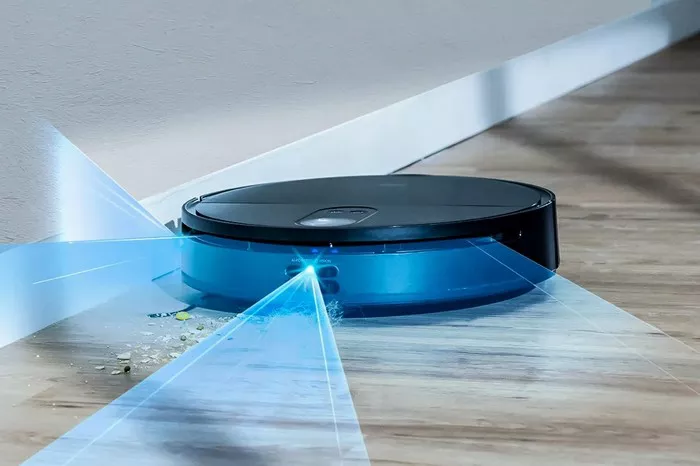In the realm of modern home automation, robot vacuum cleaners have carved a niche for themselves by offering convenient and efficient cleaning solutions. At the heart of their functionality lies an intricate navigation system that enables these machines to traverse and clean a home autonomously. Effective navigation is crucial for avoiding obstacles, mapping the environment, and optimizing cleaning paths, ensuring that no area is left untouched. The ability of robot vacuums to “see” their surroundings is facilitated by a suite of sensor technologies that work in tandem to provide comprehensive environmental awareness. In this article, we will explore the different types of sensors that robot vacuums employ to detect obstacles and map their environment, highlighting how each contributes to the overall efficiency of these smart cleaning devices.
See also: Pet Hair Removal: Your Full Guide to a Fur-Free Home
Sensing the Surroundings: A Multi-Sensory Approach
Light Sensors
Light sensors play a fundamental role in helping robot vacuums navigate their environment. These sensors detect changes in light intensity, which can indicate the presence of obstacles or the transition from one type of surface to another. For instance, when a robot vacuum moves from a well-lit area to a shadowed space, the drop in light intensity signals a change in the environment. Light sensors are particularly useful for detecting obstacles that might cast shadows, such as furniture or walls. By continuously monitoring light levels, the robot can adjust its path to avoid collisions and ensure thorough cleaning.
Infrared Sensors
Infrared (IR) sensors are a staple in the navigation systems of robot vacuums. These sensors emit infrared beams that reflect off objects in the vicinity, allowing the robot to detect nearby obstacles. When the IR beam hits an object, it bounces back to the sensor, providing information about the distance and location of the obstacle. This technology is highly effective for short-range detection and is commonly used to prevent the robot from bumping into furniture, walls, and other objects. Infrared sensors are also beneficial for edge detection, helping the vacuum to avoid falling down stairs or off ledges by sensing the absence of a nearby surface.
LiDAR (Light Detection and Ranging)
LiDAR technology represents a significant advancement in the navigation capabilities of robot vacuums. LiDAR uses laser beams to scan the environment and create detailed, precise maps. By emitting laser pulses and measuring the time it takes for them to return after hitting an object, LiDAR can determine the distance and shape of surrounding objects. This technology excels in low-light conditions, making it ideal for cleaning during the night or in dimly lit rooms. The detailed maps generated by LiDAR allow robot vacuums to plan efficient cleaning routes, avoid obstacles with high accuracy, and remember the layout of the cleaning area for future reference. High-end robot vacuums equipped with LiDAR can navigate complex environments with ease, ensuring comprehensive coverage.
Cameras (optional)
Some high-end robot vacuums also incorporate cameras to enhance their navigation capabilities. Cameras can provide visual data that complements information from other sensors, enabling advanced object recognition and more sophisticated mapping. For example, a camera can identify specific objects like toys, cables, or small furniture items that might be missed by other sensors. By processing images, these robots can avoid obstacles with greater precision and even recognize specific rooms or areas based on visual cues. While cameras add an extra layer of complexity and cost, they significantly boost the robot’s ability to navigate and clean effectively.
Building a Map for Efficient Cleaning
The data collected from these various sensors is processed to create a virtual map of the cleaning area. This map is crucial for efficient navigation and cleaning. The robot vacuum uses algorithms to analyze sensor data, detect obstacles, and plan the most efficient cleaning path. These algorithms take into account the layout of the room, the location of obstacles, and the type of surfaces being cleaned. By continuously updating the map, the robot can adapt to changes in the environment, such as new furniture or objects that are moved around. This dynamic mapping capability ensures that the robot vacuum can maintain high cleaning performance over time.
See also: Vacuum Cleaners with Steam Cleaning Functionality
Path Planning and Optimization
Path planning is an essential aspect of a robot vacuum’s operation. Using the virtual map, the robot determines the best path to cover the entire cleaning area while avoiding obstacles and minimizing redundant passes. Advanced models use sophisticated algorithms that can adapt to different cleaning patterns, such as spiral, zigzag, or edge-following modes, depending on the room’s layout and the level of dirt detected. Some robot vacuums can also identify high-traffic areas that require more frequent cleaning and adjust their schedules accordingly. This level of optimization is made possible by the seamless integration of sensor data and intelligent algorithms.
Conclusion
The integration of multiple sensors—light sensors, infrared sensors, LiDAR, and sometimes cameras—enables robot vacuums to navigate their environment effectively and autonomously. These sensors provide comprehensive data that the robot uses to detect obstacles, create detailed maps, and plan efficient cleaning paths. As technology advances, we can expect further improvements in sensor accuracy, data processing capabilities, and overall cleaning performance. Future developments may include more sophisticated object recognition, enhanced learning algorithms, and even greater integration with other smart home devices. The continual evolution of these technologies promises to make robot vacuums even more capable, reliable, and indispensable in maintaining clean, comfortable living spaces.

